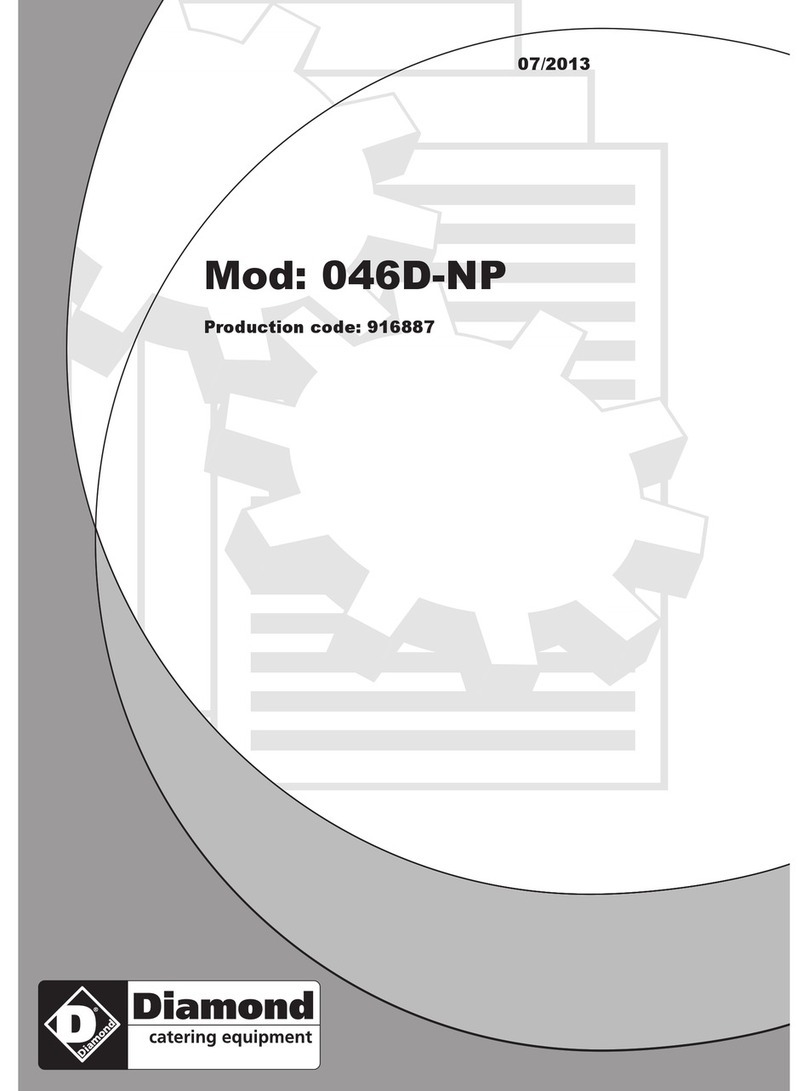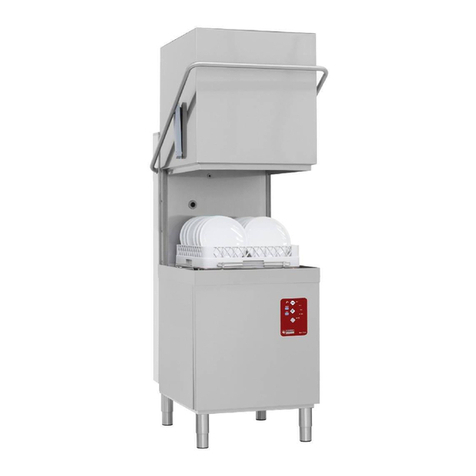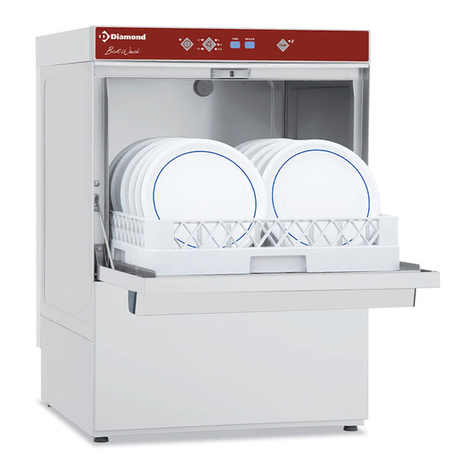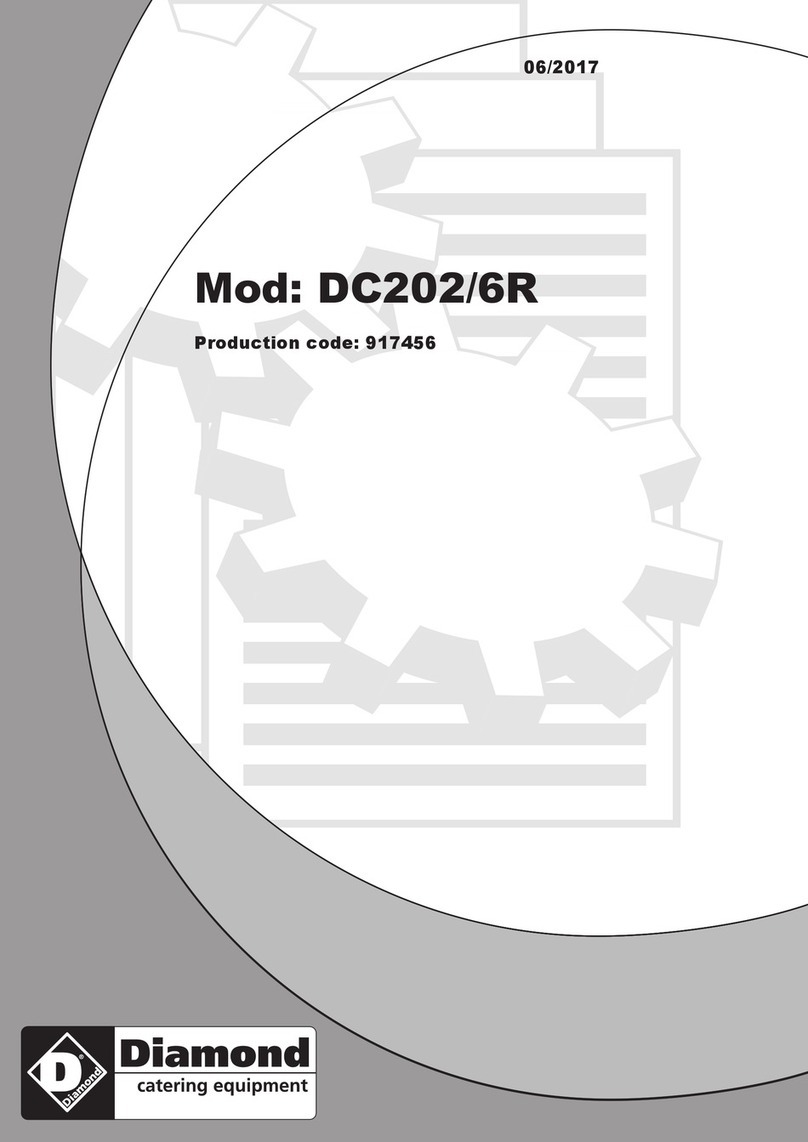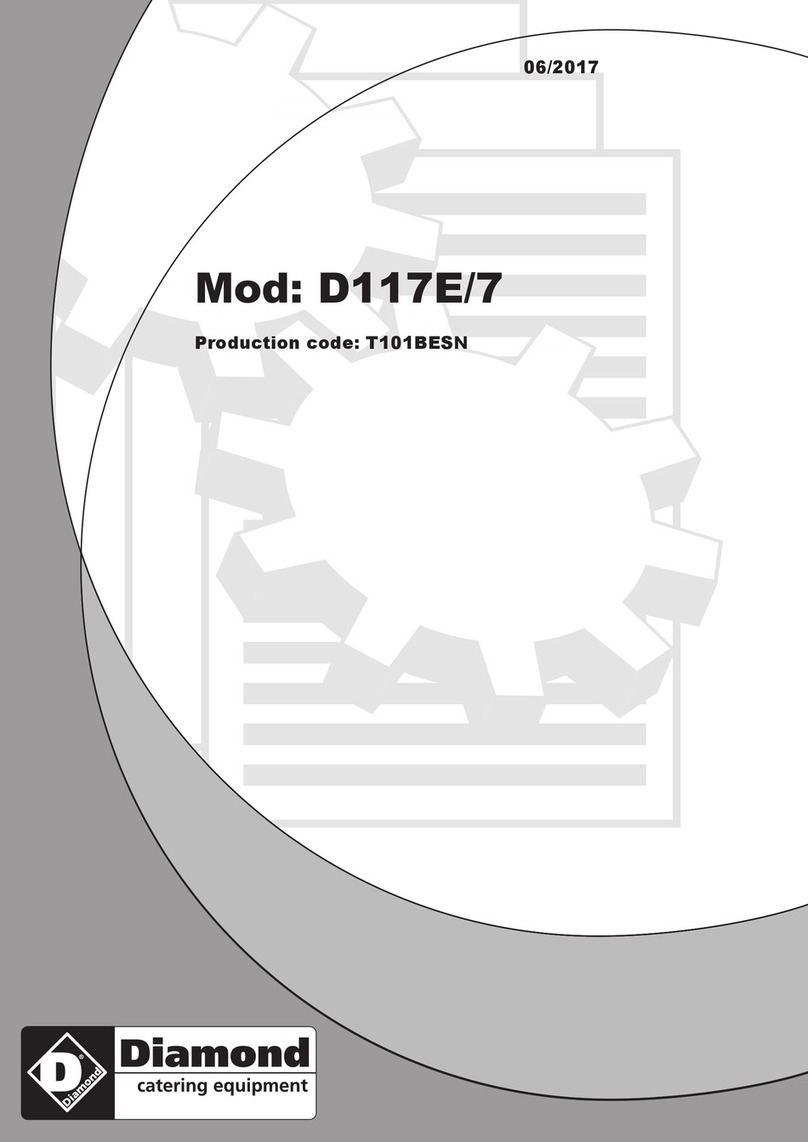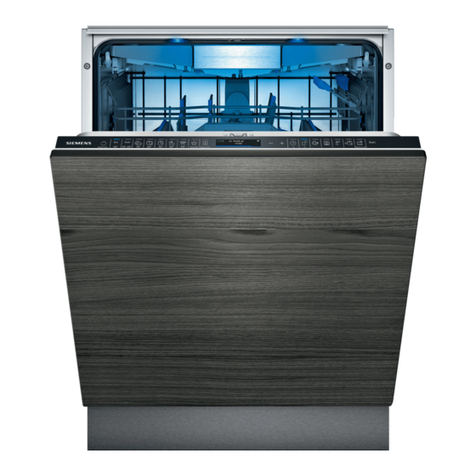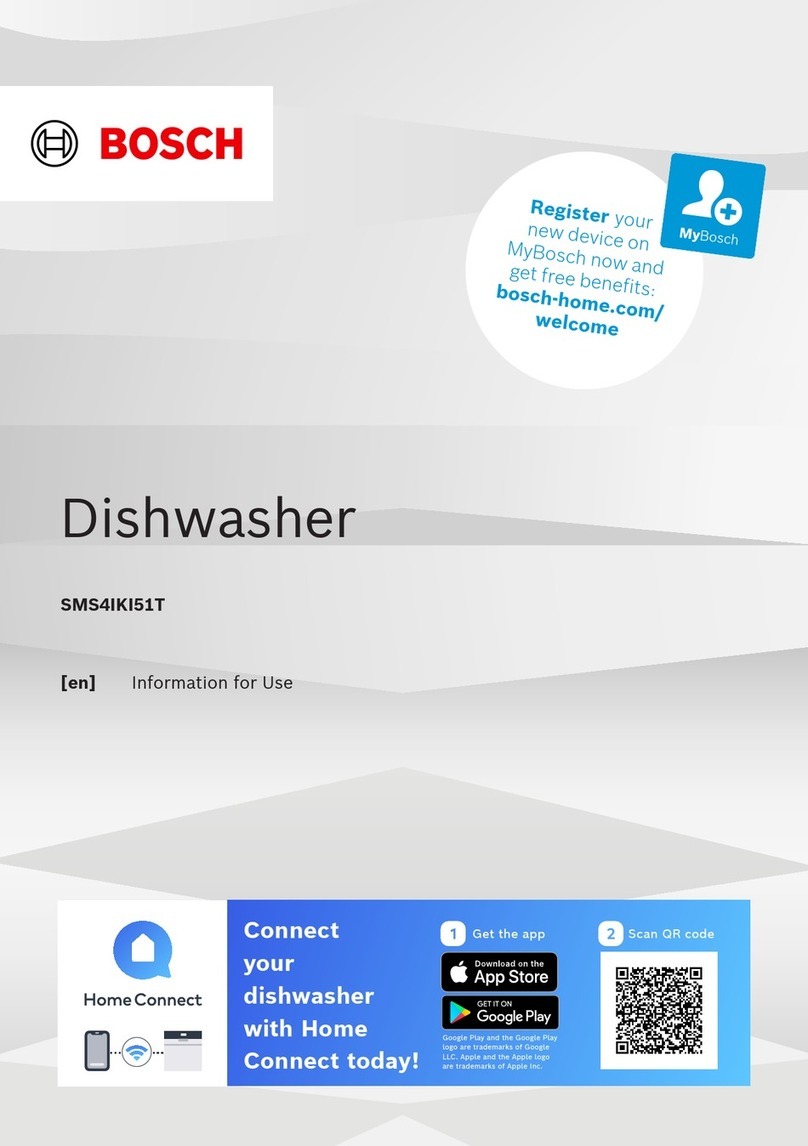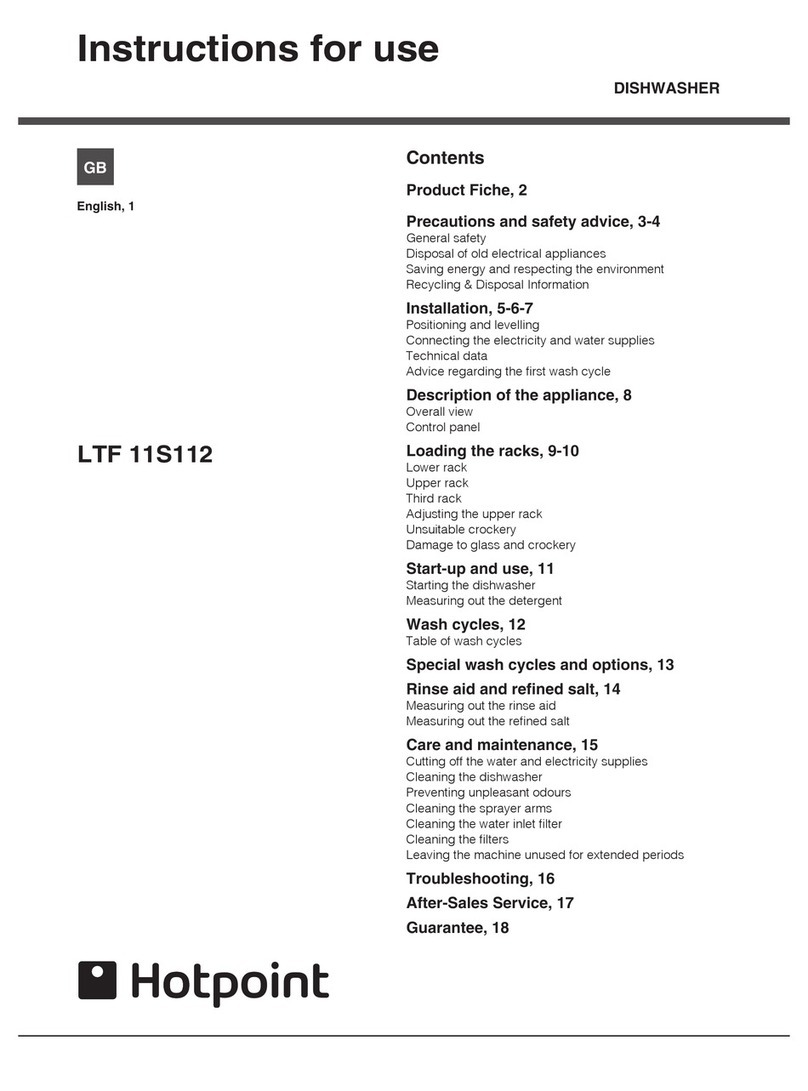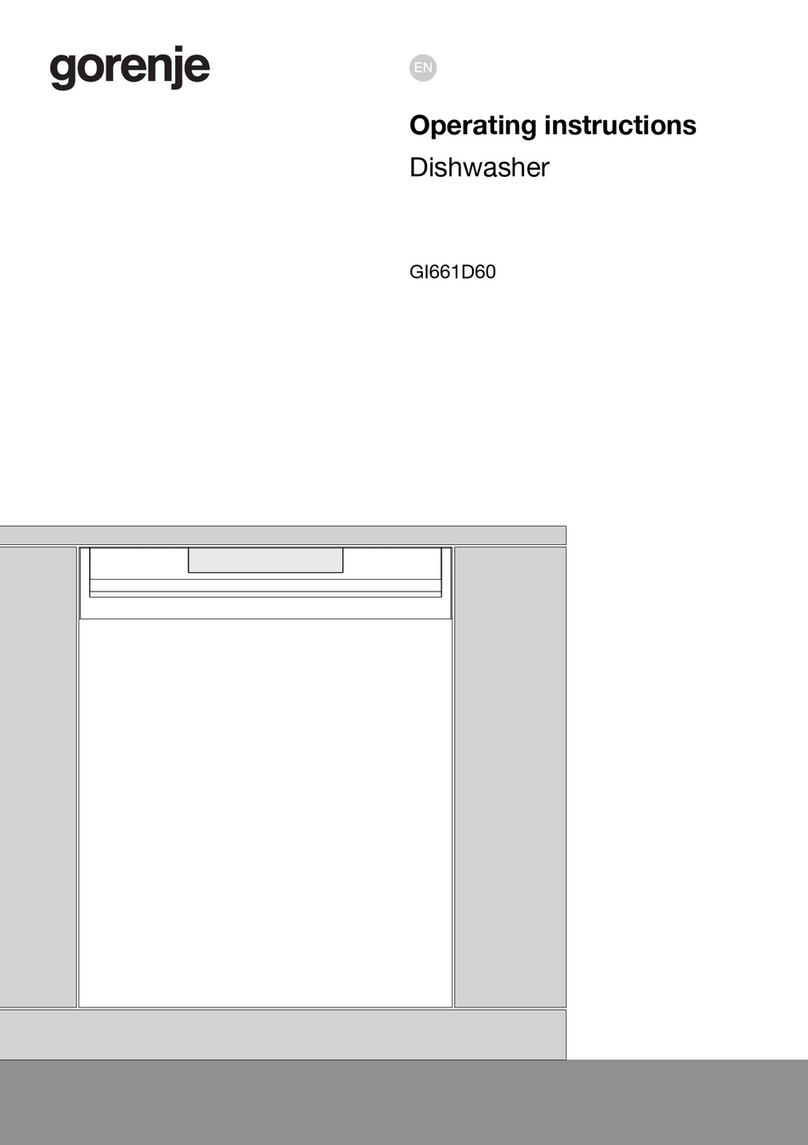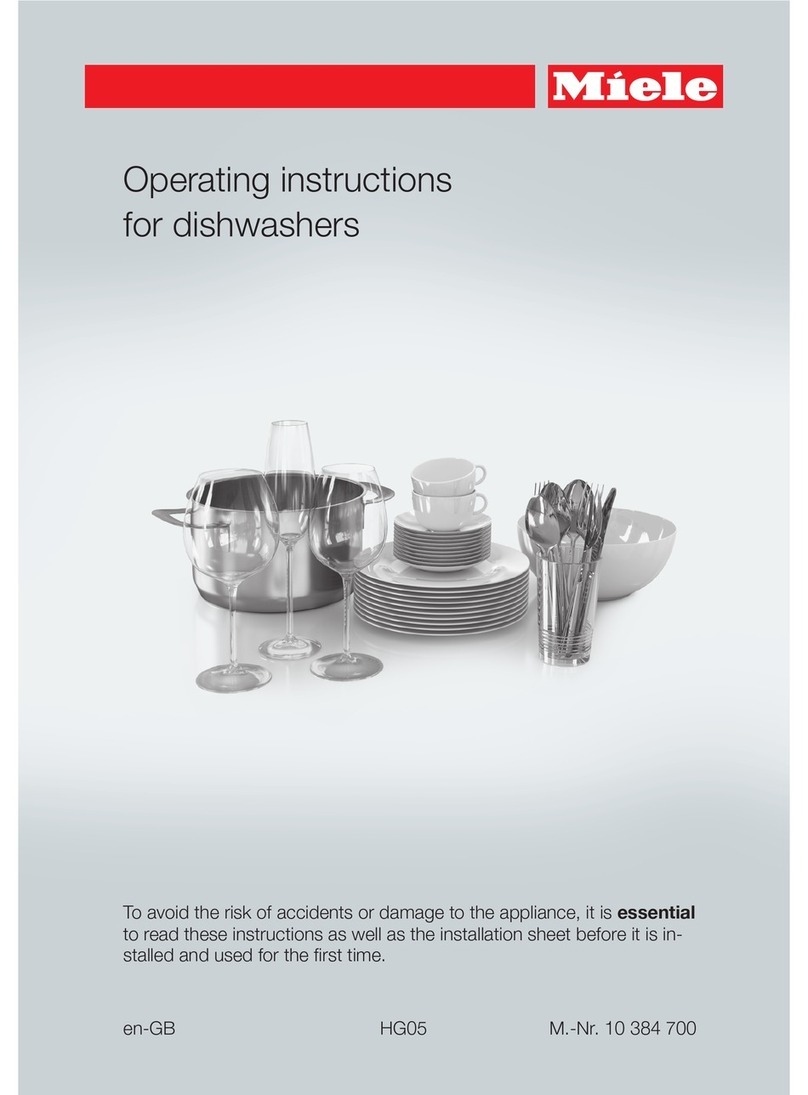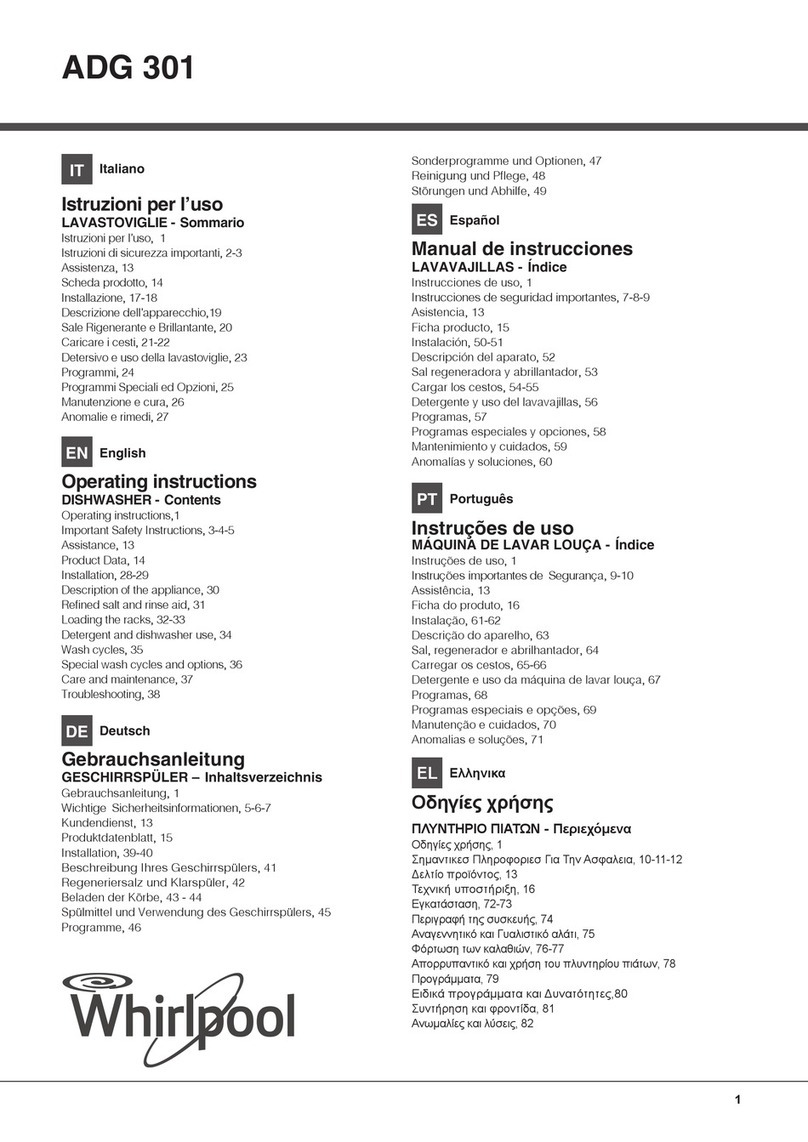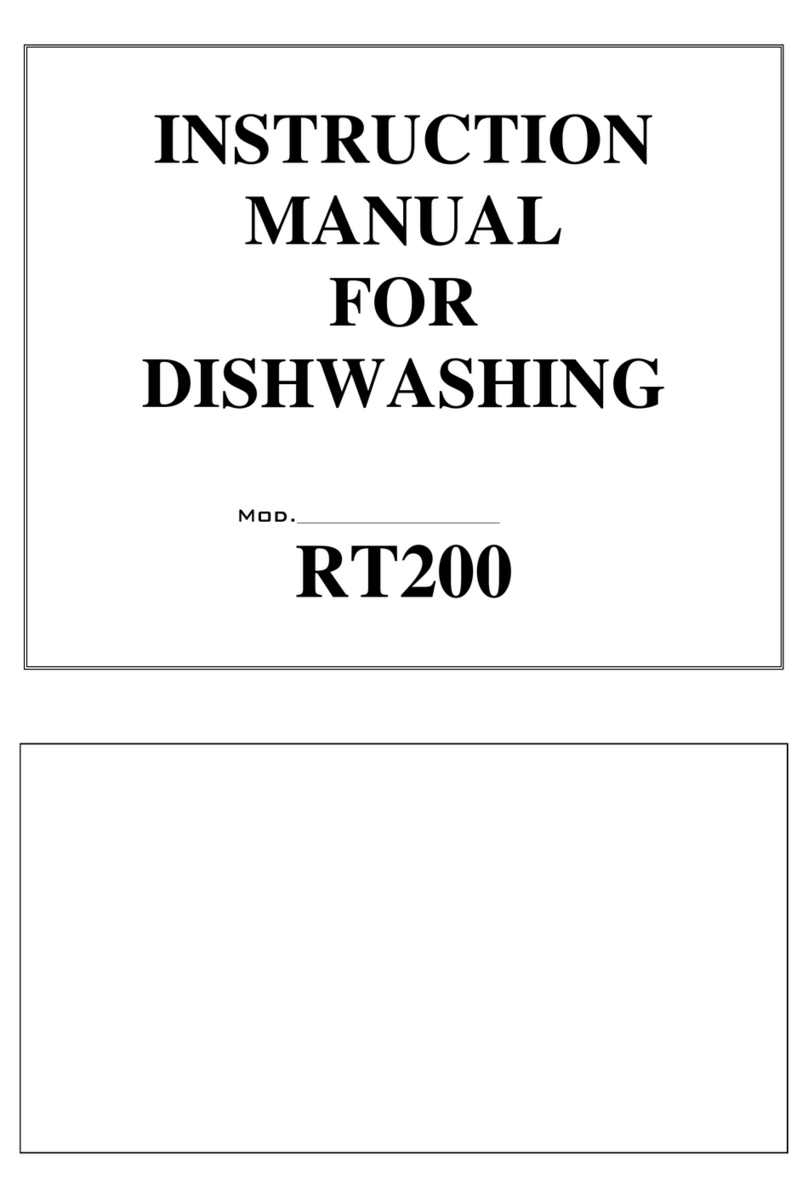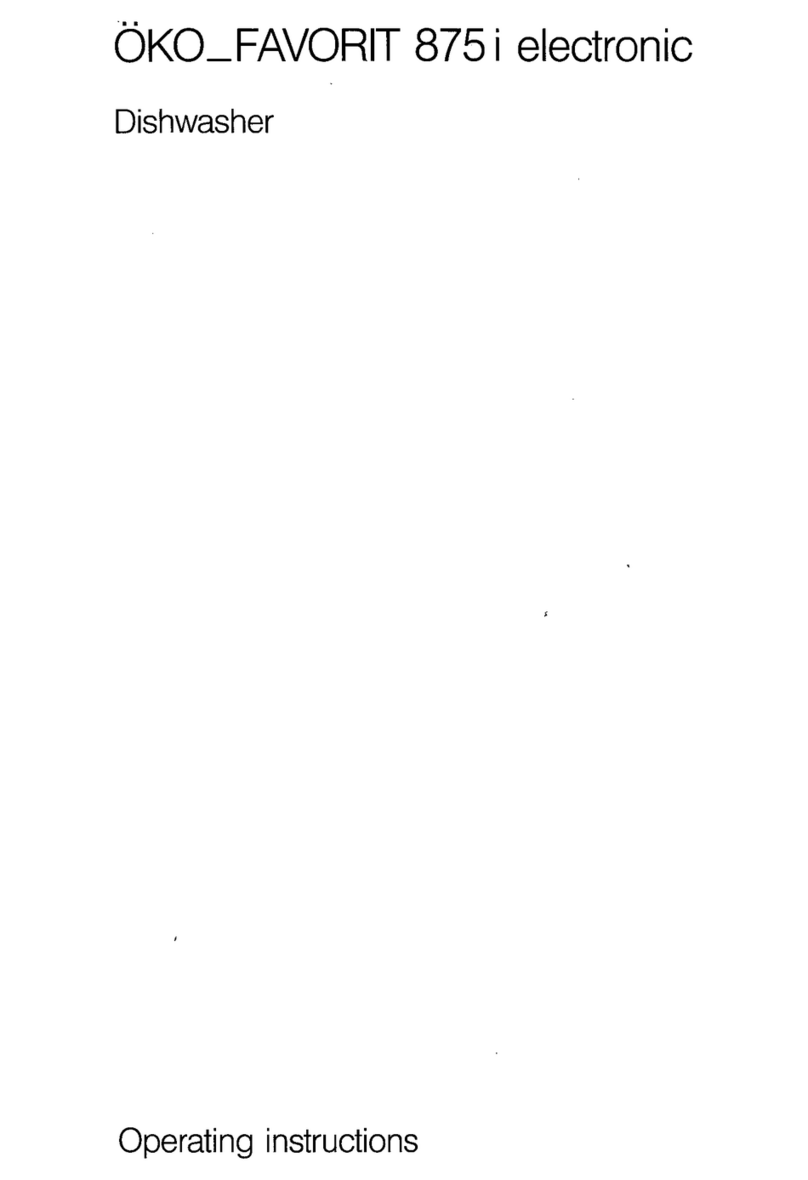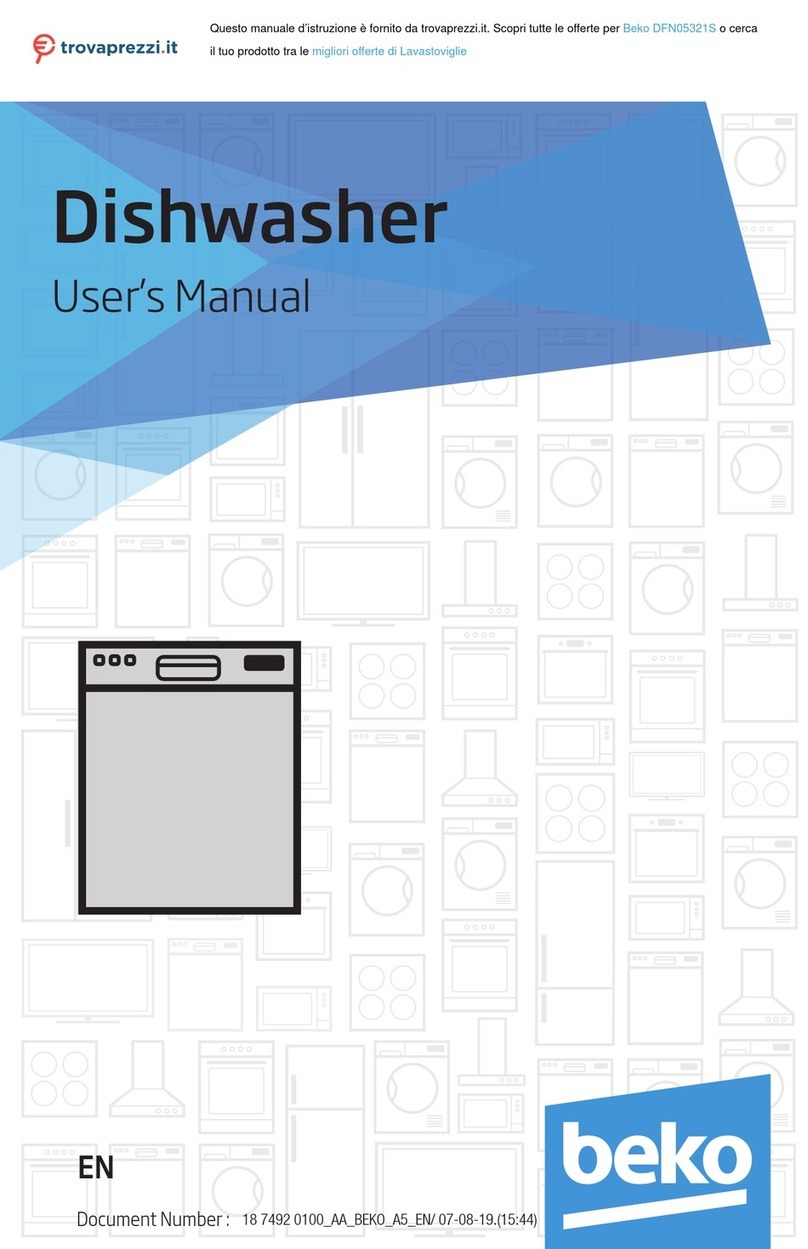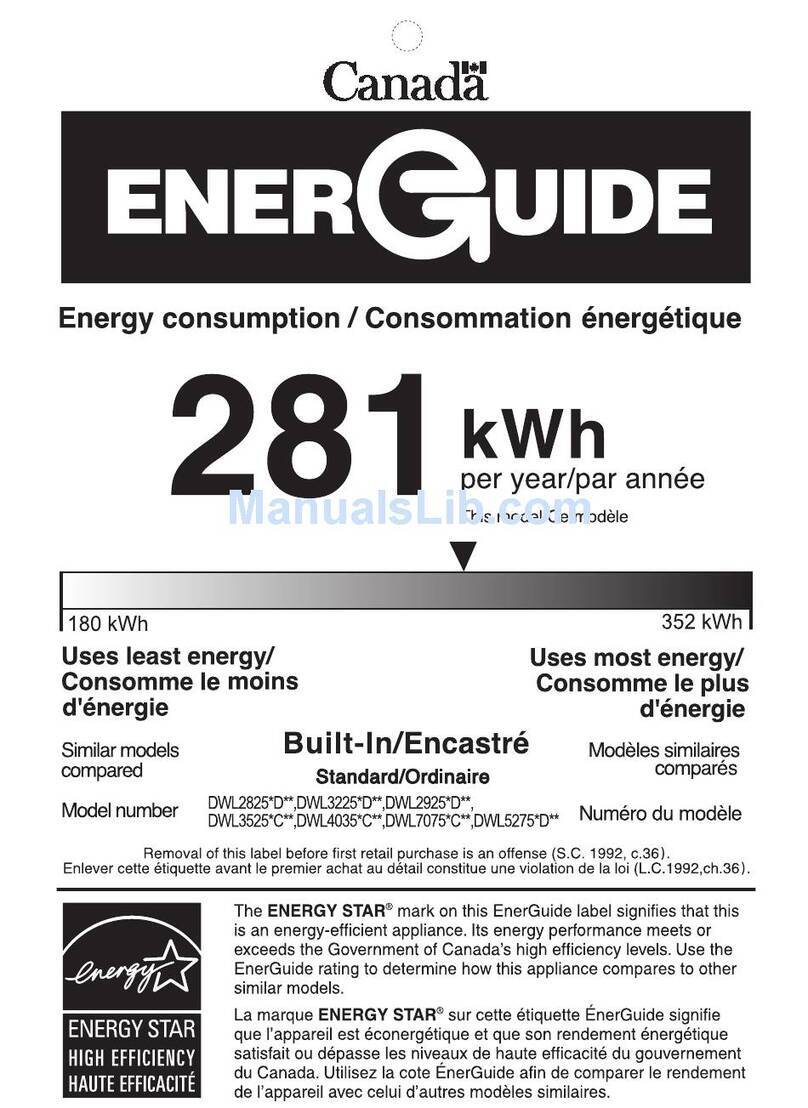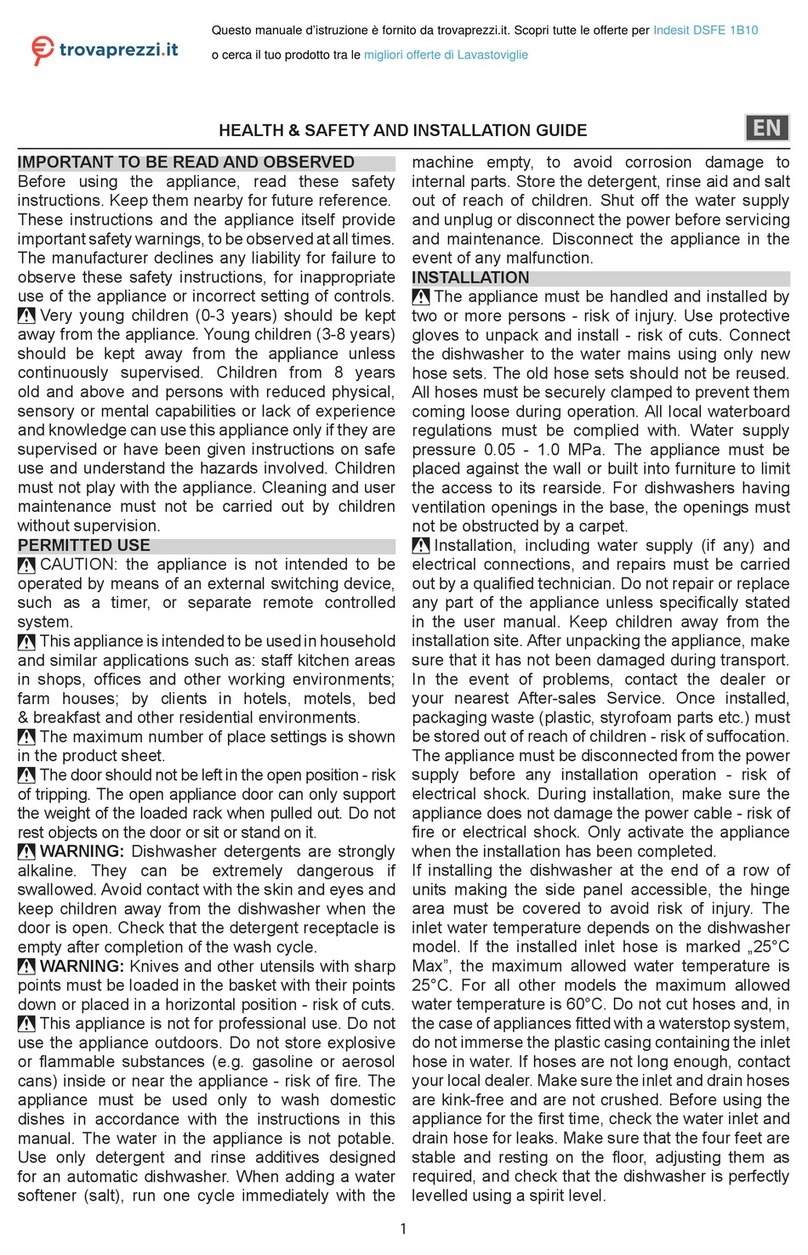Diamond Diverso WR-LV50-MC User manual

Mod: WR-LV50-MC
Production code: 919051
12/2021

INSTRUCTION MANUAL FOR DISHWASHERS
Page 1 of 10
UK
TRANSLATION FROM THE ORIGINAL INSTRUCTIONS
CONTENTS
CHAP 1 RISKS AND IMPORTANT WARNINGS......................................................................2
1.1 NORMAL OPERATING CONDITIONS ......................................................................................3
CHAP 2 PREFACE ...................................................................................................................4
CHAP 3 INSTALLATION ..........................................................................................................4
3.1 UNPACKING ......................................................................................................................4
3.2 POSITIONING.....................................................................................................................4
3.3 ELECTRICAL CONNECTION..................................................................................................5
3.4 WATER CIRCUIT HOOKUP ...................................................................................................6
3.5 CONNECTION TO THE DRAIN LINE........................................................................................6
3.6 RINSE AID AND DETERGENT................................................................................................6
CHAP 4 USING THE MACHINE................................................................................................7
4.1 KEY AND SYMBOLS ............................................................................................................7
4.2 SWITCHING THE DISHWASHER ON.......................................................................................7
4.3 FILLING THE RACK .............................................................................................................7
4.4 START CYCLE....................................................................................................................7
4.4.1 Manual start (Under-counter).............................................................................7
4.4.2 Manual start (hood)............................................................................................7
4.4.3 Automatic start-up (hood) ..................................................................................8
4.5 REMOVING THE INTEGRAL FILTER .......................................................................................8
4.6 EMPTYING THE DISHWASHER..............................................................................................8
4.6.1 Appliances with no drain pump..........................................................................8
4.6.2 Appliances with drain cycle (*optional)...............................................................8
4.7 END OF SHIFT....................................................................................................................8
CHAP 5 MAINTENANCE..........................................................................................................8
5.1 GENERAL RULES ...............................................................................................................8
5.2 CLEANING.........................................................................................................................9
5.3 CLEANING THE FILTER UNIT................................................................................................9
5.4 CLEANING THE ARMS.........................................................................................................9
CHAP 6 SCRAPPING...............................................................................................................9
CHAP 7 ENVIRONMENT........................................................................................................10
In legal terms, the manufacturer reserves the property of this document. It is forbidden to reproduce it or divulge it with any means
without prior written authorisation.
The manufacturer reserves the right to introduce changes in order to achieve the improvements it deems necessary without prior notice.
442514 MT REV00 29-11-2021 U UK

INSTRUCTION MANUAL FOR DISHWASHERS
Page 2 of 10
UK
Read the instruction manual carefully before starting the machine. The
warnings contained in the manual provide important information on safety and
installation, use and maintenance. Failure to observe the instructions in the
enclosed documentation may compromise the safety of the appliance and
immediately voids the warranty.
Chap 1 RISKS AND IMPORTANT WARNINGS
This appliance is intended solely for the use for which it was designed. Any
other use is improper and therefore hazardous.
The specialised technician responsible for installing the appliance must
instruct the user on its operation and any attendant safety measures,
including practical demonstrations.
Only the manufacturer or an authorised service centre with qualified staff may
work on the machine, even in case of malfunction, using only original spare
parts.
Always disconnect or isolate the machine from its power and water supplies
before servicing, repairing or cleaning it.
The machine may NOT be used by persons untrained in its use.
The appliance may be used by children aged at least 8 years old or persons
with reduced physical, sensory or mental capacities, or with no experience or
knowledge, provided they are supervised or after they have received training
in the safe use of the appliance.
Children must not play with the appliance.
Cleaning and maintenance by the user must not be performed by
unsupervised children.
The machine must NOT be kept powered up when not in use.
If the machine is not fitted with a plug or other device for completely
disconnecting all contacts, these disconnection devices must be incorporated
in the power supply, in compliance with the installation rules.
If the power cable is damaged, it must be replaced by the manufacturer or an
authorised technical assistance service, or in any case by a person with
similar qualifications, to prevent all associated risks.
The screw on the appliance marked with the IEC 60417 standard symbol
5021 represents the equipotential connection.
NEVER open the machine quickly if it has not completed its cycle.
NEVER use the machine with the guards installed by the manufacturer
removed.
NEVER use the machine to wash objects of any form, size or material not
guaranteed to be machine-washable or not in good condition.
NEVER use the machine or any of its assemblies as steps or support for
persons, property or animals.
NEVER overload the open door of front-loading machines, which is rated only
to support the basket loaded with dishes.

INSTRUCTION MANUAL FOR DISHWASHERS
Page 3 of 10
UK
NEVER place your bare hands in the wash solution.
NEVER overturn the machine after it has been installed.
If you notice any malfunction or fluid leak, immediately disconnect the power
supply and shut off the water supply.
Do not install the dishwasher in the vicinity of heat sources over 50°C.
NEVER leave the dishwasher exposed to the weather (rain, direct sunlight,
etc.)
The dishwasher may not be installed outdoors without proper cover.
Never start a wash programme without the overflow in the tub, as applicable.
Never place magnetic objects in the vicinity of the machine.
Do not use the top of the machine as a table or support.
The installer is responsible for checking that the grounding system is fully
operational.
At the end of testing, the installer must issue a written declaration stating that
the machine has been installed and tested in accordance with established
legislation and good practice.
DO NOT change the position or tamper with the elements of the machine, as
this could compromise the machine safety.
Noise pressure level according to EN ISO 4871
oLpA Max = 55db Kpa=2.5db for undercounter versions
oLpA Max = 65db Kpa=2.5db for hood versions
oLpA Max = 76db Kpa=1.5db for utensil washer versions
Max inlet water temperature: 50°C
Max inlet water pressure: 4bar (400kPa)
Appliance designed for permanent connection to the water supply
Do not clean the appliance with steam or water jets.
Max loading height
oOn the ground in the versions with overflow
oMaximum height 1 m in versions with discharge pump
1.1 Normal operating conditions
Ambient temperature: 40°Cmax /4°Cmin (average 30°C)
Altitude : up to 2000 metres
Relative humidity : Max 30% at 40°C / max 90% at 20°C

INSTRUCTION MANUAL FOR DISHWASHERS
Page 4 of 10
UK
Chap 2 PREFACE
Warnings:
Keep all documentation in the vicinity of the appliance; make it available to the technicians and
operators charged with operating it and keep it in good condition in a safe place, along with
extra copies for frequent reference
The operator must read, understand and familiarise himself with the contents of this
manual before working on or with the appliance.
The appliance is intended solely for professional heavy duty dishwashing applications and must
be installed, operated and serviced only by qualified persons according to the manufacturer's
instructions.
Warranty:
The manufacturer is not liable for any damage or injury resulting from failure to observe the
instructions or improper use of the machine
Failure to observe the instructions in the enclosed documentation may compromise the safety of
the appliance and immediately voids the warranty
Installation and repair by unauthorised technicians and the use non-original spare parts
immediately void the warranty.
Storage:
Transport and storage: -10°C to 55°C with peaks up to 70°C (for no longer than 24 hours)
Chap 3 INSTALLATION
Proper installation is essential to the good operation of the appliance. Some of the data required for
installation of the appliance are given on the nameplate on its RH body panel, and a copy is included
on the cover page of this manual.
The appliance may only be installed by qualified persons authorised to do so.
For Australia and New Zealand this machine must be installed in accordance with
AS/NZS3500.1
3.1 Unpacking
Check the condition of the packaging, and note any evident damage on the shipping bill. Remove the
packaging and check that the appliance is in good condition; immediately report any damage to the
reseller and the shipping agent by fax or registered letter with return receipt. If the damage is such as to
compromise the safety of the appliance, do not install or operate it until it has been inspected by a
qualified technician.
The packaging (plastic bags, expanded polystyrene, nails, etc. ) are hazardous and
must not be left within the reach of children or pets.
3.2 Positioning
Check that there are no objects or materials in the installation area which may
be damaged by the steam emitted by the appliance during operation, or if there
are, make sure they are properly protected.
Before positioning the appliance, set up the electrical power supply, water
supply and drain connections.
For flush-mounting single panel machines, leave a space of at least 10 mm
between the machine walls and the adjacent surfaces.
The floor or build-in unit must be rated to support the weight of the appliance
To ensure that it is stable, level the appliance with its four feet.
The appliance is intended for fixed installation only; any other approaches must
be agreed with and approved by the manufacturer.
Remove the protective film from its body panels before operating the
dishwasher.

INSTRUCTION MANUAL FOR DISHWASHERS
Page 5 of 10
UK
Mod.
V~
Hz
kW
A
S/N
H2O
kPa
°C
3.3 Electrical connection
The power supply must be fitted with a omnipolar circuit breaker (master power
switch) to break all contacts including neutral, with a contact gap of at least 3
mm and thermal cutout or fuses, which must be set or rated to the power
indicated on the machine's nameplate.
The master power switch must be fitted to the power line in the vicinity of the
installation and may be connected to only one machine at a time.
The mains voltage and frequency must match the nameplate ratings.
The installation must include a grounding system conforming with established
electrical safety legislation, to protect the operator and the appliance itself
This appliance conforms to EN/IEC 61000-3-11 certification if the system impedance Zsys is less
than or equal to Zmax in the point of interface between the user’s supply system and the public
system. The installer or appliance user is responsible for checking that the appliance is connected
exclusively to a supply with system impedance Zsys less than or equal to Zmax
Zmax
Utensil washers
0.21 Ω
Hood
0.24 Ω
Undercounter
0.41 Ω
The power cable, which must be exclusively type H07RN-F with current capacity at 60°C on the
cable:
Three-phase machine
o-5x2.5 mm^2 up to 20 A
o-5x4 mm^2 up to 30 A
o-5x6 mm^2 up to 38 A
o-5x10 mm^2 up to 54 A
Single-phase machines
o-3x1.5 mm^2 up to 16 A
o-3x2.5 mm^2 up to 25 A
Must not be stretched or crushed during normal operation or routine maintenance.
The appliance must also be connected to an equipotential system, connected by a screw marked
by the symbol 5021 - IEC 60417.
The equipotential cable must have a cross section of 10 mm².
Respect the polarities indicated in the wiring diagram.
For further information, refer to the wiring diagram.
Do not use multi-sockets, adapters, cables of an inadequate cross section or type or
with extensions not conforming to established electrical installation regulations.

INSTRUCTION MANUAL FOR DISHWASHERS
Page 6 of 10
UK
3.4 Water circuit hookup
The appliance must be connected to its water supply with a flexible hose. A
shut off valve (cock) must be installed between the water supply line and
the appliance's solenoid valve. The cock must be close to the appliance.
The water supply, temperature and pressure must be compatible with the ratings shown on the
technical data plate on the machine.
Make sure that the water supply flow rate is no less than 20 l/min
If the water hardness is greater than 14 °f (8 °dH), we recommend using an internal water softener.
If the water hardness is greater than 35 °f (19.5 °dH), install an external water softener upline of
the solenoid valve
For machines without water softener: if the water hardness is greater than 14 °f (8 °dH), install an
external water softener upline of the solenoid valve.
If the water has a very high residual concentration of high conductivity minerals, we recommend
installing a demineralisation system.
Machines intended for use with desalinated water or in any case with high sodium chloride
concentration must be ordered specifically, as they require specific construction materials
Do not supply fully demineralised water to machines with a heat recovery unit with batteries with
copper pipes. In this case, request the version with batteries with stainless steel pipes.
Free drain
3.5 Connection to the drain line
The drain line must consist of a free drain sump with siphon suited to
the flow capacity of the drain hose supplied with the appliance. The
hose must be able to reach the sump without stretching, restriction,
folding, crushing, pressing or forcing in any way.
The tub drains under gravity, so the drain sump must be lower than the
machine's base.
Max.
1 m
With pump (available on request)
if the drain is not lower than the base of the appliance, you can use the
version with drain pump (available on request).
In this case, the drain connection may be no higher than 1 m.
Always check that the drain works properly and is not blocked.
Any other solution must be approved by the manufacturer in advance.
3.6 Rinse aid and detergent
The rinse aid and detergent are dispensed by the machine's integral dispenser (depending on
model).
The dose is set by the installer in relation to the hardness of the water, and he also calibrates the
dispensers themselves.
Before calibrating them, fill the dispenser supply tubes with their respective product.
The units are calibrated with the adjuster screws, or directly with the control panel (as applicable).
The level of fluid in the container must be sufficient for priming; do not allow it to drain completely
or top it up with corrosive or impure product.
NEVER use CHLORINE or HYPOCHLORITE based detergents.
We recommend installing an automatic detergent dispenser.

INSTRUCTION MANUAL FOR DISHWASHERS
Page 7 of 10
UK
Chap 4 USING THE MACHINE
4.1 Key and symbols
Referring to Fig.1:
1
ON/OFF BUTTON
5
BOILER HEATING UNDERWAY LED
2
AUTO BUTTON (HOOD)
6
TUB HEATING UNDERWAY LED
3
START BUTTON
7
CYCLE UNDERWAY LED
4
POWER LED
The arrangement of buttons and leds may vary according to the machine type
4.2
Switching the dishwasher on
Referring to Fig.2:
Turn on the main power switch and open the external water tap.
Check the presence of the overflow.
Press ON/OFF (1).
The POWER led comes on and filling begins automatically.
After filling comes the heating phase; the BOILER AND TUB HEATING UNDERWAY (5.6) led
turns off when the working temperature is reached.
The optimal wash conditions have been reached.
4.3
Filling the rack
Referring to Fig.3,
to ensure the correct operation of the dishwasher follow the rules described below:
Use a suitable rack, fill without overloading and without overlapping the dishes.
Always wipe the dishes before placing in the dishwasher; do not put dishes with dry or solid
residues in the washer.
Place the empty dishes in the rack facing downwards.
Place plates and the like in the sloping rack, with the inner surface facing upwards.
Place the cutlery in the cutlery basket, handle end down.
Do not place silver and stainless steel cutlery in the same cutlery basket as this will turn the silver
brown and may corrode the steel.
Wash the dishes immediately after use, in order to prevent any residue from hardening and sticking
on them.
Use only solid, dishwasher-proof dishes.
4.4
Start cycle
4.4.1 Manual start (Under-counter)
To start the programme press the START (3) button, the CYCLE UNDERWAY (7) led lights up
(Fig.5).
When the cycle is completed the CYCLE UNDERWAY (7) led goes off
For rapid drying, remove the rack from the machine as soon as the cycle finishes.
To stop a wash cycle early, press the AUTO (2) button.
4.4.2 Manual start (hood)
Lower the hood.
Press the AUTO (2) button
To start the programme press the START (3) button, the CYCLE UNDERWAY (7) led lights up
(Fig.5).
When the cycle is completed the CYCLE UNDERWAY (7) led goes off.
For rapid drying, remove the rack from the machine as soon as the cycle finishes.
To stop a wash cycle early, press the AUTO (2) button.

INSTRUCTION MANUAL FOR DISHWASHERS
Page 8 of 10
UK
4.4.3 Automatic start-up (hood)
With the hood raised, press the AUTO (2) button for automatic start (Fig.6).
Lower the hood, the cycle starts automatically and the CYCLE UNDERWAY (7) led lights up.
When the cycle is completed the CYCLE UNDERWAY (7) led goes off.
Subsequent cycles will start automatically on closing the hood.
For rapid drying, remove the rack from the machine as soon as the cycle finishes.
To stop a wash cycle early, press the AUTO (2) button.
4.5 Removing the integral filter
Move the washing and rinsing arms at right angles to the edge of the door (Fig.7).
Lift each semi-filter by the relative handle.
4.6 Emptying the dishwasher
4.6.1 Appliances with no drain pump
Switch the dishwasher off.
If present, remove the integral filter (Fig.7 A).
Pull up and remove the overflow pipe (Fig. 8 B).
Wait for the tub to empty completely.
If necessary, extract the tub filter and clean (Fig. 8 C).
4.6.2 Appliances with drain cycle (*optional)
Switch the dishwasher off.
If present, remove the integral filter (Fig.7 A).
Pull up and remove the overflow pipe (Fig. 9).
Hold the DRAIN (3) button down until the tub is completely empty
If necessary, extract the tub filter and clean (Fig. 8 C).
4.7 End of shift
At the end of the day always drain the machine as described in the section Machine draining.
Disconnect the power supply by means of the main switch and close the external water cock.
Perform routine maintenance and clean the machine as described in the section Maintenance.
If possible, leave the door ajar to prevent bad odours building up inside the machine.
Chap 5 MAINTENANCE
5.1 General rules
Before doing any maintenance, completely drain out all water, shut off the power
supply and close the water supply cock.
Do not use water under pressure - it can damage the electrical equipment.
Only wash the body panelling when it is cold, using only product specifically designed for steel.
If there is a risk of ice forming, drain the water from the boiler and wash pump.

INSTRUCTION MANUAL FOR DISHWASHERS
Page 9 of 10
UK
5.2 Cleaning
To keep the machine in good working order, it must be maintained regularly as explained below. We
recommend periodically running a sanitising treatment with suitable non-corrosive commercial
products.
5.3 Cleaning the filter unit
Run this procedure at the end of the day or when you see the filters are dirty:
1. Remove and clean the baskets.
2. Empty out the tub as explained in “Machine draining”.
3. Remove and carefully clean all the filters.
4. Do not use abrasive products to clean the tub.
5. Restore all removed parts when finished.
5.4 Cleaning the arms
The wash and rinse arms are easily removed in order to clean their nozzles and prevent
blockage/encrustations.
Proceed as follows ( Fig.10
):
Undo nut R and remove the arms.
Wash all parts under a jet of running water and clean the nozzles thoroughly, using a toothpick or
pointed tool if necessary.
Clean the arm rotation pins inside the machine and the wash and rinse water drainage area.
Restore the arms and check that they rotate freely.
Chap 6 SCRAPPING
Our machines do not contain materials requiring special handling.
(Applicable in the EU and countries with sorted waste disposal)
The mark applied to the product or its documentation indicates that it must not be
scrapped with domestic
waste when it reaches the
end of its service life. To
prevent damage to the
environment or health risks due to
improper scrapping, keep this product
separate from other waste and recycle it
so as to promote sustainable use of
materials.
Domestic users are requested to contact
their reseller or local authority for
information on sorted waste disposal and
recycling for this type of product.
Corporate users are requested to contact
their supplier and check the terms and
conditions of the purchase contract.
The product may not be scrapped together
with other commercial waste.
Symbols
Object
Material
%
Recyclable
directly
Sheet
Steel
80
Cardboard packaging
PAP
Wooden pallet
ISPM15
Plastic parts
PP, PP+FV
Compounds
W
E
E
E
Motors
Assemblies
20
Electric parts
Electronic parts
Rubber parts
EPDM

INSTRUCTION MANUAL FOR DISHWASHERS
Page 10 of 10
UK
Chap 7 ENVIRONMENT
RESPECT FOR THE ENVIRONMENT
Proper use of the dishwasher can improve its environmental footprint, if the following simple rules are
observed:
Only wash full baskets.
Switch the dishwasher off when not using it.
Keep the machine closed when it is in standby.
Use wash programmes suited to the amount of soiling.
Supply the machine with hot water, if gas heated.
Make sure the drains flow into a suitable sewer.
Do not exceed the recommended dose of detergent.
The manufacturer reserves the right to modify the electrical, technical and aesthetic features of this
appliance and replace any of its parts without notice, as he deems necessary to offer a reliable
product with a long service life and advanced technology.
This manual suits for next models
1
Table of contents
Other Diamond Dishwasher manuals

Diamond
Diamond 046D/6 User manual
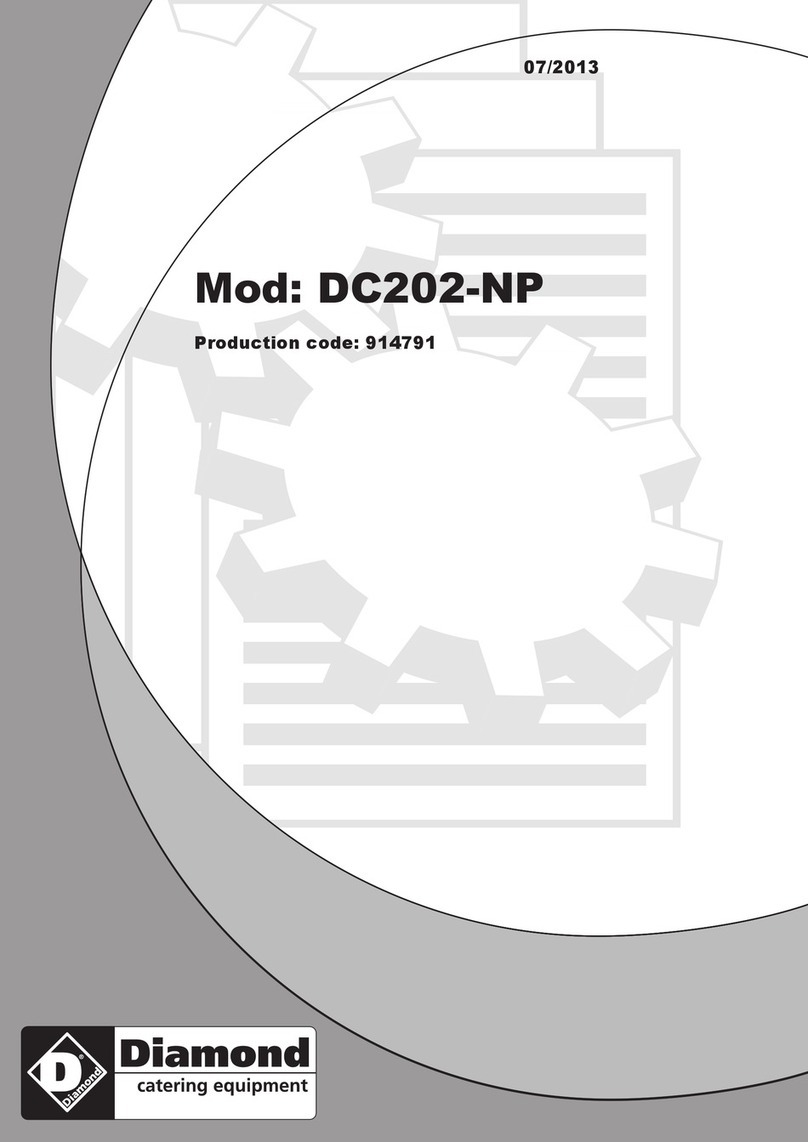
Diamond
Diamond 914791 User manual

Diamond
Diamond DC502/6 User manual

Diamond
Diamond DK7/2-NP User manual
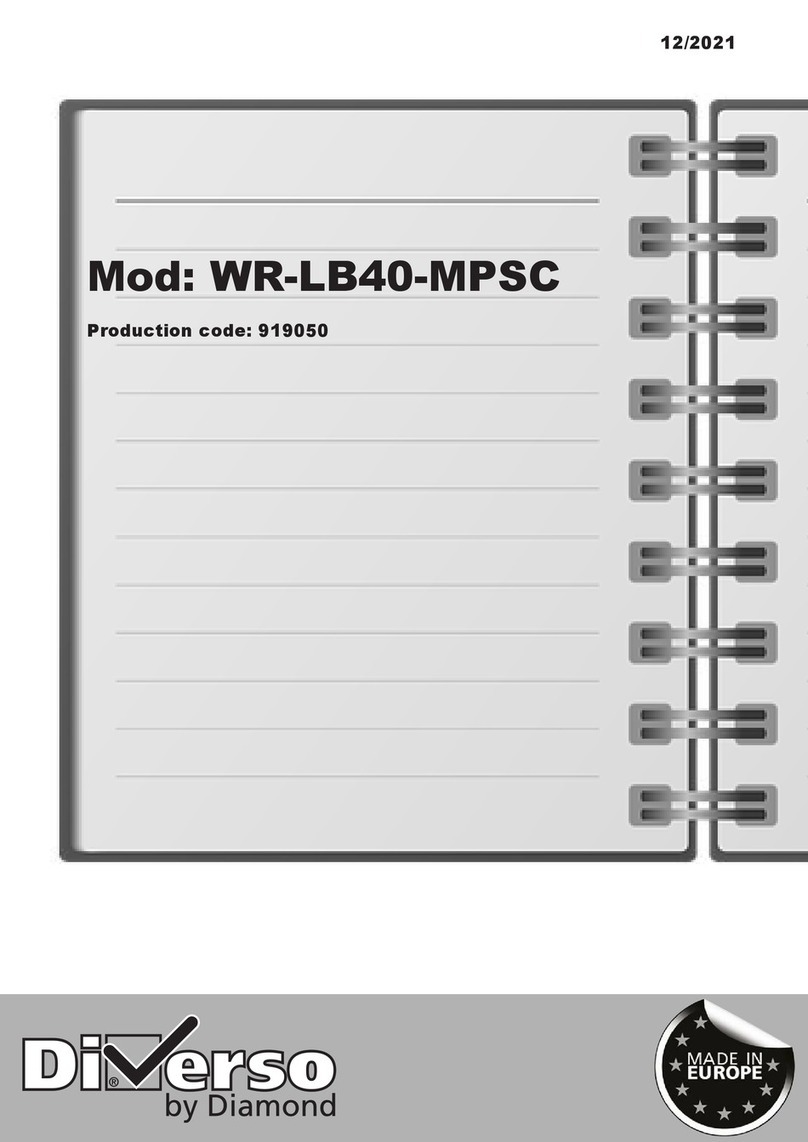
Diamond
Diamond Diverso WR-LB40-MPSC User manual
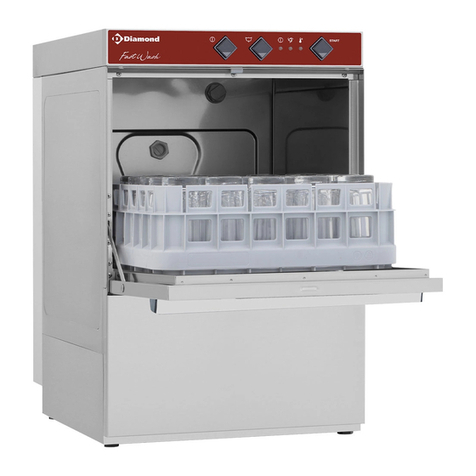
Diamond
Diamond DC402/6-A User manual

Diamond
Diamond DC402/6-PS User manual
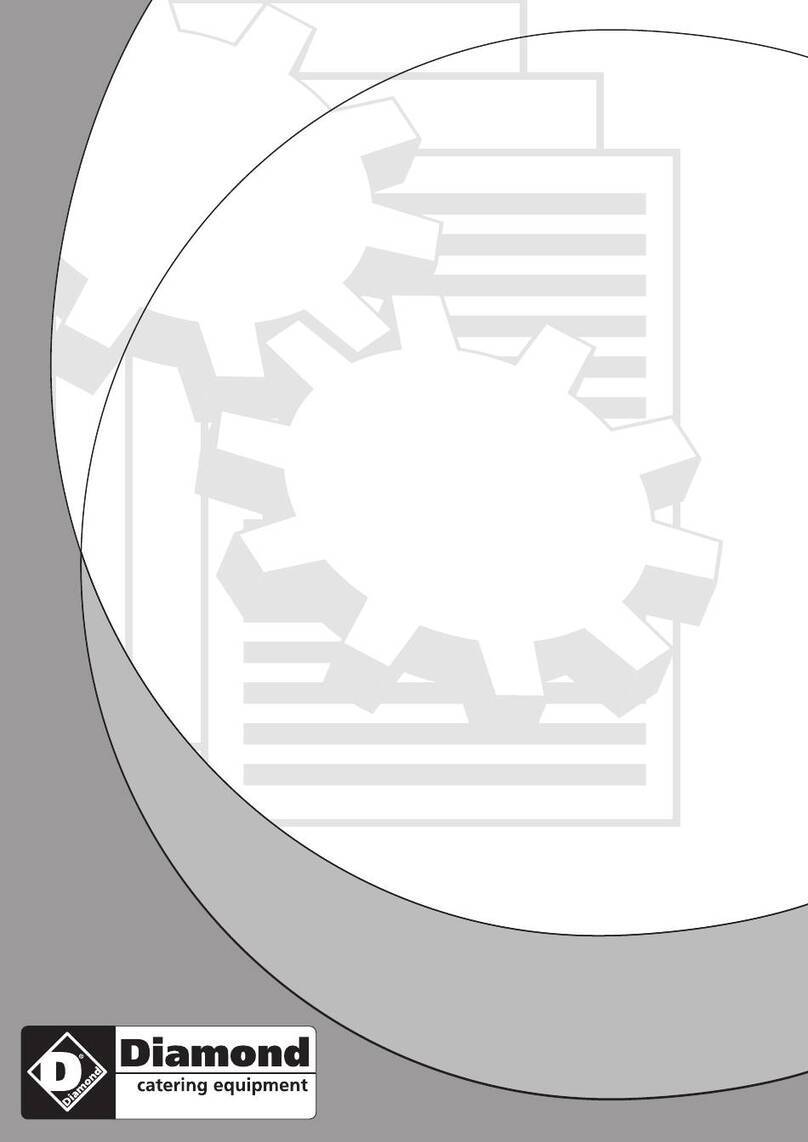
Diamond
Diamond T101BE23DN User manual
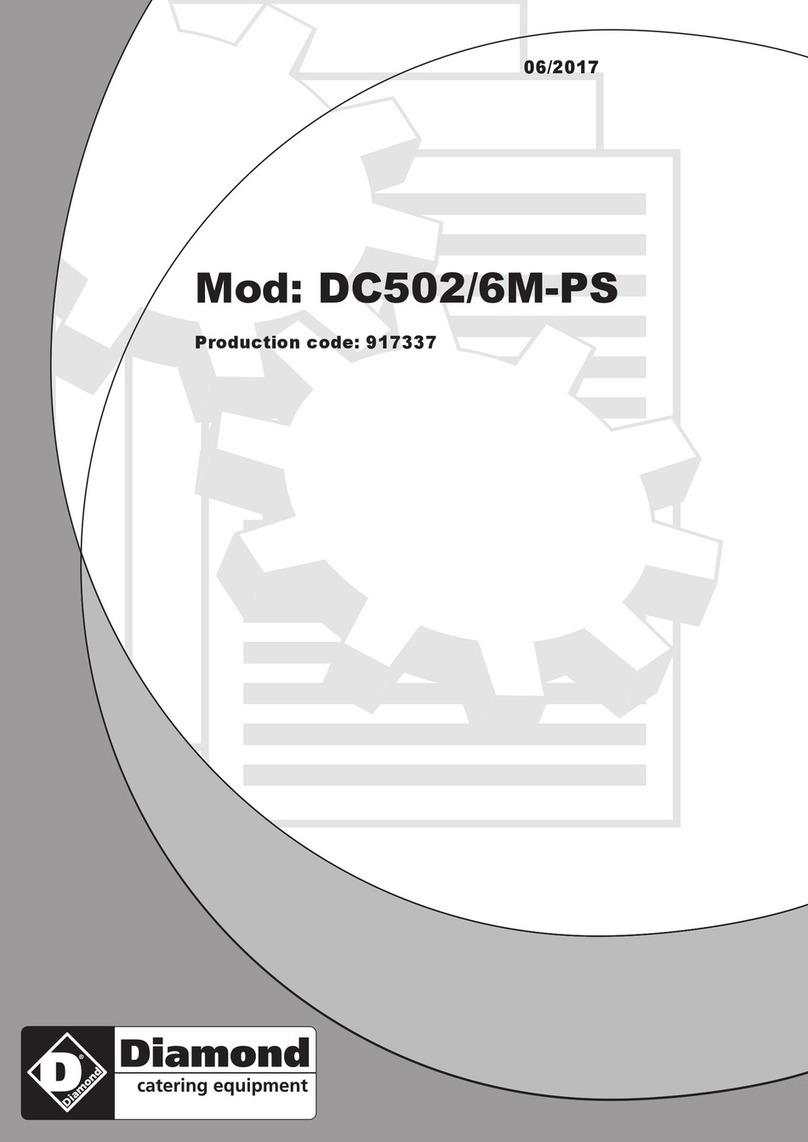
Diamond
Diamond DC502/6M-PS User manual

Diamond
Diamond DC402/6 Assembly instructions
